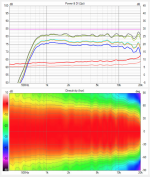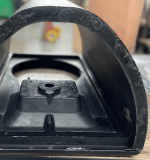As far as I know, this has never been answered. Not by Toole or anyone else.
All there is are conjectures and limited personal experiences.
All there is are conjectures and limited personal experiences.
I added to the post, probably after you read it, sorry:I have respect for your works but why you suddenly want to create a competition between X-Shape and EXAR ?
That's why I asked what can an X-Shape offer that those can't. Seems there's no such thing, right. Just to be clear on that.
It was in response to this:
X-Shape is a response of what OS cannot do, accept it, it's not a question of math but FEA.
Seems you were wrong, that's all.
Last edited:
No I said on the message after, when you asked for more detail, comparing to a regular OS horn, you are irredeemable... I don't see EXAR before you mentioned it,Seems you were wrong, that's all.
I writed :
Loading capacities comparing to regular OS (nothing exotic a basic one but with full return of course)
Again, no need to put X-Shape and EXAR in competition, I'm sure you have done a good jobs
-------------------------------------------------------------------------------------------------------------------
For Toole and DI I can give an example, one of my contact is very advanced man in mathematics and passionate about acoustics literature (he have read everything).
The kind of man that you need for spaceship program.
He ask me a "Toole" based project, basically it's a 2D map of his dedicated room (here a photo of the actual situation) :
He give me every octave (1khz,2khz,4khz ... multipli by 2 each time until 16khz) the horizontal coverage needed at 1° precision associate with the DI (so it's naturally dictate vertical), and with a low xover.
Of course he have calculated the DI decay at a particular acceleration according to his need (and reading => Toole and more).
By using tiny horn that use side walls as horn horizontal walls and calculate the DI by simulation wave front total pressure difference to axis.
(it can look strange)
It's an extreme demand but illustrate well the things about DI/psycho-acoustic, brain interpretation of direct field/ reverberated field and brain time of integration of the two field...
Of course I don't said that an extreme demand like this is the things to do.
It seems that you actually like competition, but only if you feel you have an edge 🙂Again, no need to put X-Shape and EXAR in competition, I'm sure you have done a good jobs
haha, I don't feel like I have a particular edge, each person has their own way to think, work and develop a product, for me the group of 5 push me in a direction by their acoustical needs, nothing more 😀
NicoB has a company and products.It seems that you actually like competition, but only if you feel you have an edge 🙂
NicoB has a group of 5 who work together for a higher goal and seem to get along.
NicoB has solutions for real customer wants and needs – from DIY to Professional.
Mabat has wonderful ideas and lots of experimentation on paper, and a few prototypes.
Mabat has software that is no longer supported.
Mabat has a few followers/supporters.
Where is the competition?
You could accomplish so much more by removing that large chip from your shoulder. You are your own worst enemy. Ath4 is coming to end because of your behavior. It's a self-induced tragedy.
Last edited:
NicoB has a company and products.
Who cares about ?! 🙂
I don't like Mabat's some communication manners, but I should be objective and recognize he spent a lot of time on the development of ATH and math for CD horn calculation and, what is most important, he shares his results with the DIYaudio community for free. Many DIYers uses his software. Personally, I did not never use (and I do not plan to use) nor ATH, nor the OS-related formulas developed by Freehafer/Geddes/mabat, but I have respect for Mabat for his hard work for free for Diyaudio community.
Last edited:
And who are you to judge?
I like technical discussions from which all participants can benefit, but this is far from anything like that, so I'll refrain.
What I can't stand is dishonesty and BS in general.
Thanks for the mention.However, it appears that his solution for 'midrange narrowing', what I had called 'waist-banding', is the same as an answer that I had received from @limacon when I commended him for his great simulation results. I cannot find the precise post, but he basically advised me that in order to reduce midrange narrowing on a baffled device, numerous simulation iterations and versions of baffle-box-waveguide-systems were required.
Yes, I simulated about 20 or 30 enclosures in low res first (15 mins each on a 10 core i7).
Then closed down on a cabinet shape and approx sealed 35L.
Cast PU + 50% chalk powder + 1% chopped strand glass fiber.
Here is the HF10AK.
700Hz 6th order butterworth = electrical 950 2nd Order Q1.1 highpass + two EQ.
300mm rotation from CD exit.
Measured with Motu M4 and LineAudio OM1.
I have the measurements with 12P80ND (Qtc 0.26 with insane EQ) & 3012HO (Qtc 0.56)
A few others too, maybe 12PR320.
I think I read @Patrick Bateman said once he is notorious for not finishing projects.
These have been WIP for 3 years and changing every other month or so.
Not possible without ATH4.


Last edited:
I'm not sure that people in general realize that the formulas I presented are so universal that everything from straight conical to exponential (most probably also JMLC and all that stuff) can be created using them. With the benefit of the inherently smooth termination, no matter what the basic shape is. It just so happened that a hyperbola turned out to be very convenient as a foundation.Personally, I did not never use (and I do not plan to use) nor ATH, nor the OS-related formulas developed by Freehafer/Geddes/mabat, ...
- BTW, there's no real "OS waveguide" - it simply doesn't exist, it would have to be infinite. Even if a finite part was an exact OS, the rest will never be, and it's what determines the results as importantly. (The waveguides I make are not exact OS anywhere, not even at the throat, just to be clear on that.) That's just what I feel important to mention every time I see someone (as NicoB) talk about "OS" - it's lacking any technical rigour.
Last edited:
I'm not sure that people in general realize that the formulas I presented are so universal that everything from straight conical to exponential (most probably also JMLC and all that stuff) can be created using them. With the benefit of the inherently smooth termination, no matter what the basic shape is. It just so happened that a hyperbola turned out to be very convenient as a foundation.
I downloaded you latest R-OSSE pdf and I see you use some kind of very comlex parametric curve with 8 independent parameters even for axisymmetric horn. For example, why not just use a Bezier curve instead of this curve ? With Bezier you can also draw also almost anythig you want 🙂.
Last edited:
So you previously commented on something you weren't even familiar with? Why it still surprises me.
I just see good reasons to do it this way.
I just see good reasons to do it this way.
So you previously commented on something you weren't even familiar with?
I didn't say that. I said I never used and plan to use OS by Freehaver/Geddes /Mabat. And it is true.
And yet, why not just use a Bezier curve instead of your R-OSSE curve? 🙂
No, you didn't say that. You only commented on someting you knew nothing about.
Because my way you can easily and in a straightforward way control the basic design choices you want. Doing this with general Bezier curves, and at the same time allowing for flexibility to optimize the shape, would be quite complicated.
Because my way you can easily and in a straightforward way control the basic design choices you want. Doing this with general Bezier curves, and at the same time allowing for flexibility to optimize the shape, would be quite complicated.
Last edited:
If you can put everything is "OS" terms it's impossible to compare something to "OS" are there is everything inside, but you right about the fact that you formula can create almost everything.- BTW, there's no real "OS waveguide" - it simply doesn't exist, it would have to be infinite. Even if a finite part was an exact OS, the rest will never be, and it's what determines the results as importantly. (The waveguides I make are not exact OS anywhere, not even at the throat, just to be clear on that.) That's just what I feel important to mention every time I see someone (as NicoB) talk about "OS" - it's lacking any technical rigour.
EXAR is not the common OS and have a part that is not "OS" that people see in Geedees design, so in fact for me EXAR is no more an OS, it's your horn that you design with OS based formula at some part (I guess) 👍.
EXAR is just a R-OSSE profile in its fundamental description, a bit special in that it goes through a hexagonal shape in the middle part - done numerically.
I have also some strictly axisymmetric designs as well, then it's a pure R-OSSE with an extension duct attached.
(It's Geddes, not Geedees. Please, let's have at least this correct.)
I have also some strictly axisymmetric designs as well, then it's a pure R-OSSE with an extension duct attached.
(It's Geddes, not Geedees. Please, let's have at least this correct.)
Very good it what I mean an modern OS with your extension duct, but the overall result is not something standard, it what I mean but that is very good, I hope to see good results, no doubt about it 🙂
Sorry for Mr. Geddes, my apology if you read it sir.
Sorry for Mr. Geddes, my apology if you read it sir.
The attached extension doesn't change the acoustic behaviour of the horn in any way other than adding efficiency. So it's really still the same horn, in a way, only improved on the "lumped element" level.
You should try it too with your "OS Horn" 😉 (or any other horn, in fact)
You should try it too with your "OS Horn" 😉 (or any other horn, in fact)
- Home
- Loudspeakers
- Multi-Way
- Acoustic Horn Design – The Easy Way (Ath4)